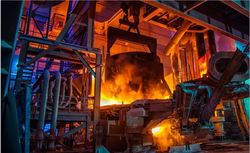China’s record steel output supports cape rally

Nation is expected to maintain high levels of iron ore imports with record high steel production and falling domestic output. This plays well with capesize owners in the coming months as Brazil increases output.
World’s largest steel-producing nation to keep iron ore imports high, with Brazilian grades favored.
A STRING of official data from China lately suggests the world’s largest steel-producing nation needs larger quantities of overseas iron ore to maintain record high output, boosting market confidence for strong capesize markets for the coming months.
Beating earlier forecasts of soft growth this year, China’s crude steel production grew 6.3% on year to 532.9m tonnes during January-July 2018, according to National Bureau of Statistics data cited by various media outlets.
In July, China’s production amounted to 81.2m tonnes, a record high and 7.2% higher on year.
Arctic Securities said in a note: “The increase in production comes on the back of high margins, policy makers’ promise to boost infrastructure investment, as well as the increased use of imported, high-grade iron ore.
“[China] continues to curb exports and cut excess production capacity, and with continued inventory draws, fundamentals should reflect strong demand for steel as well as for dry bulk shipping (particularly for capesizes loaded with high-quality steel-making ingredients).”
China’s iron ore imports reached nearly 90m tonnes last month, up 8.1% on month, according to reported customs figures.
The strong increase was partly driven by a recovery in shipments from Brazil, where much of the high quality grade was produced, driving up demand for capesize bulkers in longhaul trade.
Capesize average spot earnings have outperformed other sizes of bulkers on the Baltic Exchange, hovering above $25,000 per day this month.
This has lifted the Baltic Dry Index to 1,725 points as of Monday, not far from the previous peak of 1,774 hit on July 24, the highest since 2014.
In efforts to curb pollution, China has been closing iron ore mines domestically, a development that will likely to lead to a continued high level of imports.
Before adjusting for quality differences of Chinese production, China’s iron ore output fell 38% on year to 391m tonnes in the first half of 2018, according to Clarksons Platou.
“Total Chinese iron ore inventories has been drawn down this year, which bodes well for the seasonal upswing on capesize rates in the second half of 2018,” the brokerage said in a note.